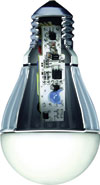

Global concerns over climate change require using our limited energy resources more efficiently. For a cleaner and sustainable future, energy efficiency plays a key role. Approximately 20% of the global electrical energy is consumed for lighting applications. The transformation to new, intelligent LED lighting technologies for residential and commercial lighting allows significant energy savings.
With an increasing number of countries banning incandescent lamps in favour of energy-saving alternatives, 230 V operated LED lamps are emerging as the favoured replacement. The charm of these so-called retrofit LED lights is that they require minimal or even no change or modification of the original socket and control gear.
This advantage is generally accompanied by the customers’ requirement that the overall performance of the LED retrofit must be equal to or even better than the original incandescent solution. What this means for the LED driving solution is that:
* The complete circuitry must be designed in a space-saving way, to fit into a standard socket;
* High efficiency is desired to minimise thermal design efforts;
* Easy to design, for a fast time to market.
For the consumer who installs the LED retrofit at home, two additional requirements are important:
Especially for 230 V LED bulb retrofits, good dimming performance is one of the most (if not the most) important features;
The LED solution must not flicker when there is a variation in voltage at the supply rail.
Infineon is offering innovative solutions to deal with these challenges. The newly introduced off-line LED driver ICL8002G sets high standards with respect to integration, performance, features and total system cost. It employs quasi-resonant operation modes with integrated power factor control (PFC) for off-line (230 V) residential LED lighting applications in particular for 40 W/60 W/100 W incandescent bulb replacements.
Applied primary control techniques result in system efficiencies of 90% while external component count is kept low. The resulting compact driver design can easily be embedded within the standard screw-in form factor. The ICL8002G outperforms current regulatory requirements and is prepared for the future. Together with an external CoolMOS switch, it is easily scalable and presents a solution to implement multiple LED bulb designs with one controller.
When it comes to ease of designing, Infineon offers designers an online design tool in the form of Lightdesk (accessed via www.infineon.com/lighting). It is available for the whole ICL(S)8xxx family and helps customers to design the transformer, which is the most critical external component in such a system. Furthermore, the tool gives guidance on the other external components and lets users share their results and designs with others.
As good dimming performance is a key requirement, Infineon has put a strong focus on this issue during product development. The ICL8002G has broad compatibility with leading- and trailing-edge phase cut dimmers found in most homes.
To provide smooth dimming, without distortion in the light output, the IC has a continuous dimming curve, similar to dimming an incandescent lamp. It also incorporates integrated circuitry to ensure a stabilised light output when trailing-or leading-edge dimming is active.
The stabilisation of the light output also accounts for very good line regulation. With integrated digital fold-back current correction, variations in the supply voltage will not have a visible effect on the light output.
For more information contact EBV Electrolink, +27 (0)21 402 1940, [email protected], www.ebv.com, Electrocomp, +27 (0)11 458 9000, [email protected], www.electrocomp.co.za
| Tel: | +27 11 458 9000 |
| Email: | [email protected] |
| www: | www.electrocomp.co.za |
| Articles: | More information and articles about Electrocomp |
| Tel: | +27 11 236 1900 |
| Email: | [email protected] |
| www: | www.ebv.com |
| Articles: | More information and articles about EBV Electrolink |

© Technews Publishing (Pty) Ltd | All Rights Reserved